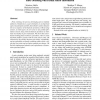Free Online Productivity Tools
i2Speak
i2Symbol
i2OCR
iTex2Img
iWeb2Print
iWeb2Shot
i2Type
iPdf2Split
iPdf2Merge
i2Bopomofo
i2Arabic
i2Style
i2Image
i2PDF
iLatex2Rtf
Sci2ools
ICRA
1998
IEEE
1998
IEEE
Parts Orienting with Partial Sensor Information
Parts orienting, the process of bringing parts in initially unknown orientations to a goal orientation, is an important aspect of automated assembly. Bowl feeders used in industry rely on a sequence of mechanical operations, without using sensors, to orient parts. In our work, we use partial information sensors along with mechanical operations to eliminate uncertainty in part orientation. We show that sensorbased orienting plans need Om operations, where mis the maximum number of states with the same sensor value. We characterize the relation between part shape, orientability, and recognizability to identify conditions under which a single plan can orient and recognize multiple part shapes. We describe implemented planners and experiments to demonstrate generated plans.
Related Content
| Added | 04 Aug 2010 |
| Updated | 04 Aug 2010 |
| Type | Conference |
| Year | 1998 |
| Where | ICRA |
| Authors | Srinivas Akella, Matthew T. Mason |
Comments (0)

